Science Fiction Gallery
I had several ideas for science fiction settings over a period of a few years, much of it never ended up online. I had always wanted to write out some sort of big worldbuilding project that would tie everything together, but many of the ideas were equally interesting yet incompatible. If you want to try and come up with a coherent setting out of all this, be my guest.
2021 - 2020 : Terraforming, Maps
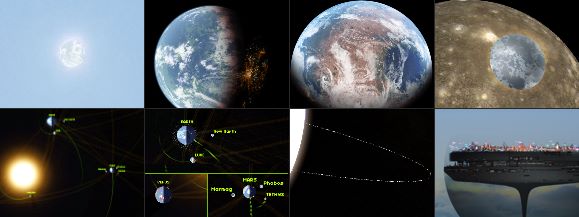
1. The moon after terraforming - seen from Earth. 2. The moon after terraforming. By this point the Moon has surpassed Earth as a populated hub of the solar system. 3. Mars after resuming and completing terraforming. View is of one of Mars' remaining deserts. 4. A part of Callisto sealed off and pressurized. 5/6. A map of the solar system with an emphasis on scale and distances. 7. After devestation on Earth, a new kind of civilization forms. Spaceships are parked in orbit and repurposed into living spaces for millions of evacuees and spacefarers. A new space-based culture develops. 8. ('shop of Ralph McQuarrie's art) A realistic(?) flying city concept. In use after the Second Space War.
2020 - 2019 : Terraforming, Galaxies
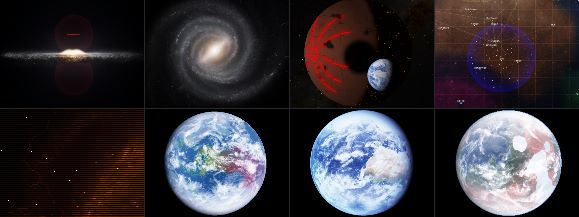
1. Side view of the Milky Way galaxy. A handful of aliens come from planets outside the galactic disk. The Fermi bubbles must be avoided when travelling there. 2. My most realistic attempt at 'shopping the Milky Way Galaxy. 3. The Intergalactic Federation reveals itself to Earth, and envoys inform us of our debt incurred after millions of years of their clandestine protection. 6/7/8. (Originally made in 2018, then refined in 2019.) 6. Venus; Terraformed with unusually colored flora. 7. Earth; in the middle of a decades-long winter. 8. Mars; Terraformed but rather cold.
2020 - 2019 : Maps, Galaxies
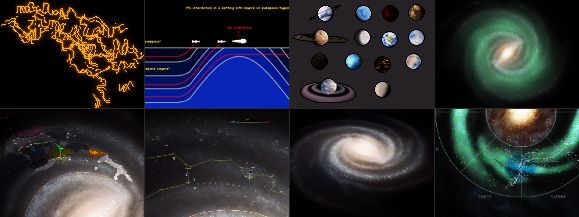
1. Sample of whip-spider writing. 3. Pictographic planet icons. 4. Habitable parts of the galaxy, much more generous interpretation and (considering the way stars orbit) more realistic than the other one. 5/6. Galactic civilization maps. 7. Milky Way Galaxy. 8. Interpretation of the habitable parts of the galaxy, forming a visible kind of galactic "geography."
2019 : Galaxies
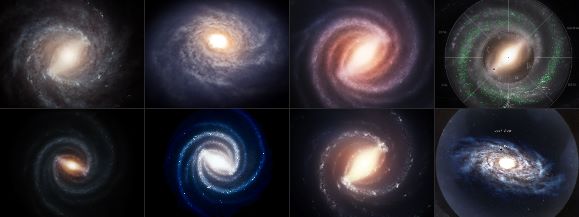
1/2/3/5/6/7. Various rendering of the Milky Way Galaxy, experimenting with different colors and styles. 4. Map of the homeworlds of roughly 400 sapient species within the Milky Way Galaxy. 8. Holographic map depicting a 2000-lightyear diameter circle then explored by humans. (appears as a dot)
2019 : Planets, Megastructures
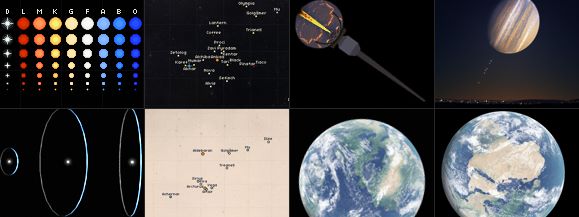
1. Star types. 2/6. Maps of inhabited stars within 100 lightyears of Earth. 3. Ships depart from a massive FTL carrier. 4. City lights under the glow of a gas giant 900 lightyears from Earth. (Space Engine 'shop) 5. Three rings representing the ancient origins of civilization, a center of culture and trade in the galaxy. 7. Hot and wet future Earth. 8. Hot and dry future Earth.
2019 : Maps, Spaceships
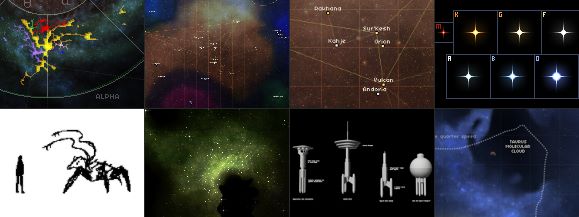
1. An interpretation of interstellar colonization, where instead of an expanding bubble, fast ships haphazardly colonize and leave untouched systems, so that territories resemble a loose intersecting web. 2/3. Humans form an alliance with a number of alien races in a part of space called the tetrahedron. (ignore the placeholder names) 4. Star types. 5. An intelligent alien species resembling a whip spider. Dangerous, yet open to diplomacy. 7. Interstellar spacecraft used by humans, post-contact with aliens.
2019 : Maps, Stars
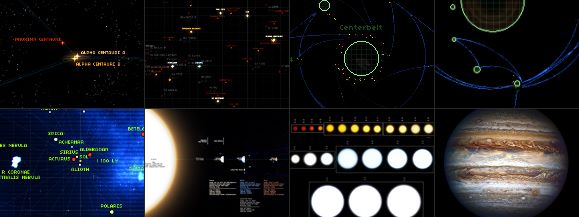
1. Map of the Alpha Centauri system with an Oort cloud surrounding it. 2. Map of stars within a few lightyears of Earth. 3. After devestation on Earth, a new kind of civilization forms. Spaceships are parked in orbit and repurposed into living spaces for millions of evacuees and spacefarers. A new space-based culture develops. 4. Travel routes around Jupiter, a complicated affair compared to later centuries. 5. Local starmap. 6. Early interplanetary colonization. 7. Star types. 8. In the not-too-distant future Jupiter looses it's red spot.
2019 : Planets, Terraforming, Stations
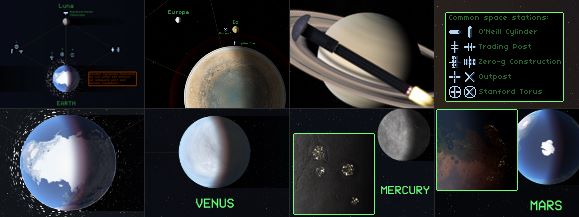
1. Colonies at Earth's Lagrange Points. 2. In Jupiter's orbit, a spacecraft rated for heavy radiation is a requirement. 3. A Titan carrier brakes as it approaches the Saturn system. These massive ships take round trips in an era where Saturn is the frontier of civilization. 5. During the Second Space War, Kessler Syndrome broke out in Earth's orbit. In the years since, travel to the surface is possible, but requires skilled pilots. 6. Venus; partial terraforming. 7. Crater cities in Mercury's poles. 8. Mars after resuming and completing terraforming.
2019 : Planets, Moons, Terraforming
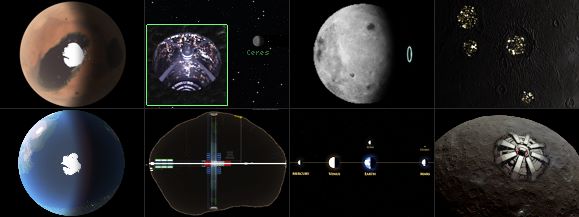
1. Mars at the start of being terraformed. 2. "Tube" city on Ceres. Rotates for gravity. 3. A large settlement on the Moon. 4. Crater cities in Mercury's poles. 5. Mars; After terraforming. Nearly it's entire northern hemisphere is now a single ocean. 6. Cross section of Phobos roughly 120 years after it's first inhabitants. 8. Space Colony Ceres on Ceres! Get it? Never mind.
2019 - 2018 : Planets, Canvas art
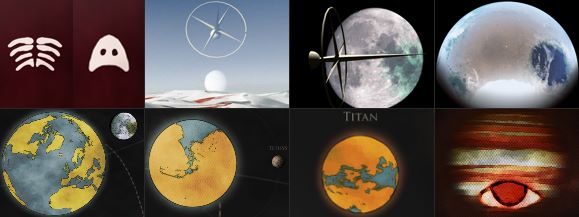
1. Flags of Mars after the Age of Caesars. 2. The Crown II uses gravity technology to hover above the frozen surface of Mars. 3. The Crown II with the moon in view. A kind of mold has been slowly taking over the surface since the abandonment of the moon's settlements. 4. Mars after the abandonment of terraforming, resulting in a habitable yet terribly cold and desert-filled world. 5/6/7/8. Planet paintings after the Age of Caesars. 5. Earth, with swollen oceans and discoloration on the moon. 6. Mars, partially terraformed.
2018 : Mars, Spaceships
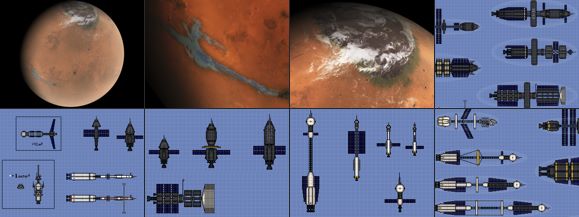
1/2/3. Mars at the start of being terraformed. 2. Valles Marineris is sealed off to allow for a pressurized atmosphere. 3. Closeup of the water at Mars' north pole. 4.5/6/7/8. Various interplanetary spacecraft. 4/8. FTL-capable variants.
2018 : Spacehips, Planets, Aliens
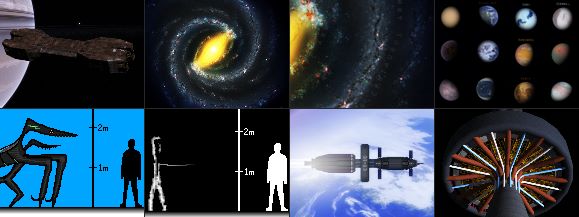
1. The Dogbone Artifact - an ancient derelict spacecraft originating from outside the galaxy, discovered orbiting within the rings of a gas giant. 2/3. Milky Way Galaxy with dramatic colors. 4. Far-flung worlds reached by refugees from Earth. 5. Highly advanced nomadic race. No concept of personal space. 7. Explorer vessel departing from orbit. A ring in it's center allows for faster-than-light travel. 8. Early warp drive.
2018 : Spaceships, Maps

1. Enzmann starship. 2. A space whale with natural warping abilities travels near Earth. 3/4. Early FTL explorer, with a spinning habitable saucer in the front. 6/7. A few centuries after first contact, human civilization (now including uplifts and AI) begins to encounter and map out other interstellar civilizations. 8. Standard spacecraft popularized in the 43rd century. Rings are still cheaper than artificial gravity.
2018 : Nonsense ideas
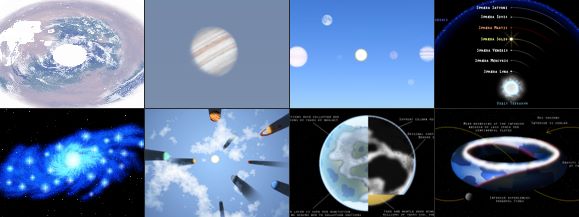
1. Flat Mars theory. 2. Jupiter viewed from an Earthlike atmosphere. A terraformed planet, or meerly a telescope shot form Earth? 3. What the planets would look like if they were much closer. 4. Ptolemy map of the cosmos. 5. Oldschool painted-looking galaxy. 6. Bright and sunny day in space. 7. Cross section of a crumbling artificial shell-world. 8. The elusive doughnut-world. (theoretically possible)
2018 : Wormholes, Megastructures, Terraforming

1. Bishop Ring. Growingly common colonization method in the 43rd century. Equivellant to only a fraction of Earth's surface. 2. Spherical wormhole. 3. Callisto with most of the surface tented over to retain an atmosphere. 4. 30 meter sea level rise. Clouds removed for clarity. 5. Mars after the abandonment of terraforming, resulting in a habitable yet terribly cold and desert-filled world. 6. Mars terraformed - this time with no desert left on the planet. 7. An artificial solar system is made with several dozen planets orbiting the same star as an interstellar empire finds itself unable to defend it's far off extremities. 8. O'Neill cylinders combined into a larger structure.
2018 - 2017 : Spaceships, Planets, Spaceships & Stations
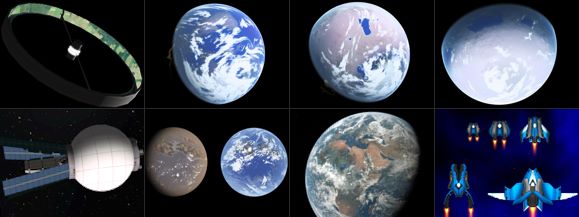
1. Small Stanford Torus orbiting Earth. It's ring simulates a nice countryside. 2/3/4. Attempt at giving an old planet generator (LunarCell) realistic looking settings. 4. Tidally locked planet. 5. Spacecraft with a habitable section tucked behind a large fuel store. 6. Before and after of a watery planet's terraforming. Made for Sean McKnight's "Second Renaissance" setting. 7. Earth after the construction of artificial lakes in the Sahara. Made for Sean McKnight's "Second Renaissance" setting. 8. Silhouette-theory of character design applied to spaceships. Inspired by an old flash game, Starfighter: Disputed Galaxy.